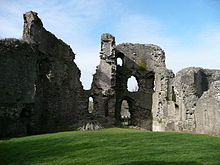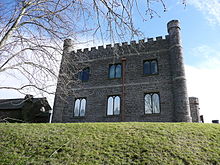- Abergavenny Castle
-
Abergavenny Castle is a castle in the market town of Abergavenny, Monmouthshire in south east Wales.[1]
Contents
A naturally fortified site
The castle was sited above the River Usk overlooking the river valley and the confluence of the rivers Gavenny and Usk. The site would have been naturally defensible in earlier times and may well have been a fortified site in the Bronze and Iron Ages. Later it was also favoured by the Romans who built their fort of Gobannium on the same hilltop, just a little to the west of the site later developed into the castle. There were steep slopes down to the river on three sides, and the town developed on the remaining side of the castle, probably on the site of the Roman fort and settlement. The main castle gatehouse faced the town, which was later walled.
Norman origins
The castle has Norman origins: the early motte is recorded as having been built by Hamelin de Balun on the order of William the Conqueror in 1075.
Abergavenny Massacre
In 1175 Abergavenny Castle was the scene of an infamous act: the Massacre of Abergavenny. Henry Fitzmiles, the third son of Miles de Gloucester, 1st Earl of Hereford had been killed by a Welsh leader, thought to be Seisill ap Dyfnwal of Castell Arnallt, in 1165. As there were no other male heirs, his brothers all having died without issue, the castle together with lands in Brecknockshire and Upper Gwent passed via his sister Bertha, a daughter of Miles de Gloucester, 1st Earl of Hereford, to Bertha's husband William de Braose, 3rd Lord of Bramber.
William de Braose, now Lord of Abergavenny, decided to avenge the death of his wife's brother Henry. He summoned Seisill ap Dyfnwal, his eldest son Geoffrey, and a number of other leading local Welshmen, from Gwent to Abergavenny Castle to hear a royal proclamation. He then had them put to death when they expressed disapproval of the proclamation. William was "retired" from public life for this abuse of a royal safe-conduct and Abergavenny was taken over by his son and heir, another William de Braose, 4th Lord of Bramber.
In 1182 Abergavenny Castle was attacked after William de Braose had been defeated in battle and Dingestow castle towards Monmouth destroyed.
Control of the castle passed back and forth during the turbulent years as the Welsh Marches changed hands in the 12th century between English and Welsh forces.
In 1233 the castle was sacked by Richard Marshal, 3rd Earl of Pembroke during his alliance with the Welsh leader Llywelyn the Great.
During the 13th and 14th centuries much building work was undertaken on the castle whilst it was in the hands of the Hastings family. The most prominent features that remain from this period are the towers on the western side of the castle.
Owain Glyndŵr Rebellion
During the rebellion of Owain Glyndŵr in the early 15th century the town of Abergavenny was sacked and burned by Welsh forces in 1402, as were other English held settlements in Monmouthshire such as nearby Grosmont and Crickhowell. However Abergavenny Castle succeeded in defending itself against an infantry attack, and could have withstood a siege if necessary. A small garrison of archers and men-at-arms could defend a castle against an army and such an arrangement usually deterred any attack. Chepstow Castle, although much larger than Abergavenny Castle, had a garrison at that time of only 20 men-at-arms and 60 archers, and was avoided by Glyndŵr's forces altogether although they successfully sacked Newport Castle. The gatehouse of Abergavenny, and the newest part of the castle, dates from 1400 and was probably a measure taken to fortify the castle further in the light of the rebellion.
English Civil War
The stone keep, along with most of the other internal castle buildings, shell keep and towers, was damaged badly in the English Civil War when the castle suffered slighting to prevent it becoming a stronghold. The ruins that can be seen today are largely the result of this deliberate damage [1]. Raglan Castle was similarly damaged.
Present day
In 1819 the present square "keep" building, now housing the Abergavenny Museum, was constructed on top of the motte as a hunting lodge for the Marquess of Abergavenny. The grounds are laid to lawn and are used for events such as open air plays and historical re-enactments; for example the anniversary celebrations in 1990 of the castle's founding, marking 900 years of history.
References
Further reading
- Remfry, P. M., Radnor Castle, 1066 to 1282, ISBN 1-899376-03-8
External links
Coordinates: 51°49′11″N 3°01′01″W / 51.819593°N 3.016821°W
Categories:- Castles in Monmouthshire
- Castle ruins in Wales
- Abergavenny
- River Usk
Wikimedia Foundation. 2010.


